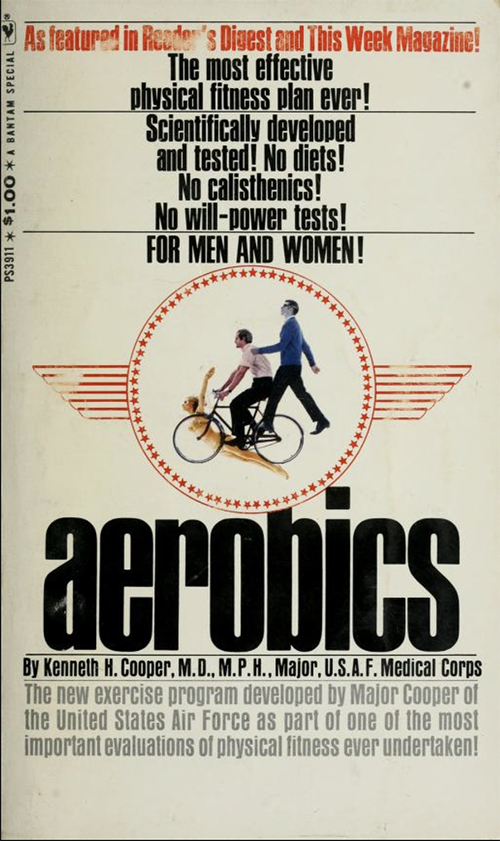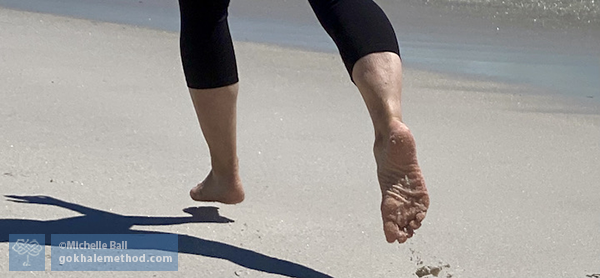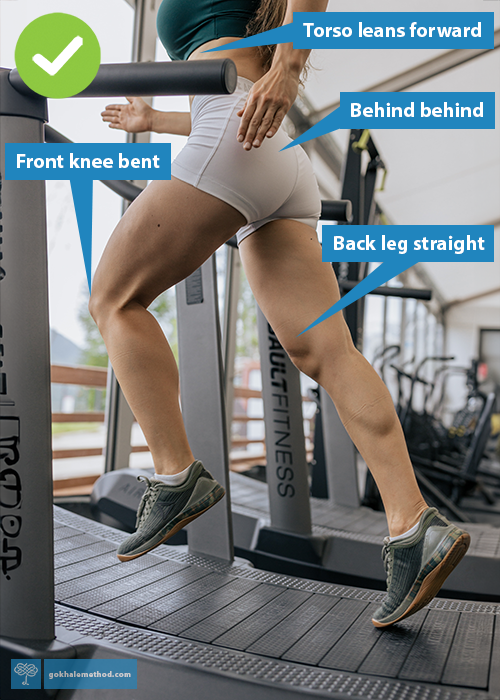During the Victorian Era, a British engineer, William Cubitt, invented the treadmill as a means of harnessing hard labor in prisons and penal colonies. It was also used unproductively, purely as a punitive measure. Despite this sordid history, the treadmill has become a highly beneficial and enjoyable device within the context of a contemporary lifestyle.
The sedentary nature of modern life in the industrialized world leaves most of us with less than the ideal amount of physical activity. In 1968 the importance of aerobic exercise was popularized by the book Aerobics by Kenneth H. Cooper. Inspired by this book, the first electric consumer treadmill was developed by another American by the name of William Edward Staub.

The book Aerobics by Kenneth H. Cooper did more than any other to promote the role of “aerobics” for health, founding a paradigm that continues to this day. Aerobics by Kenneth H. Cooper
Staub’s invention was enthusiastically taken up and the exercise treadmill is now used by some 50 million¹ plus Americans and millions more around the globe. The treadmill has several benefits over running outside:
- It provides a controlled environment and avoids inclement weather
- It can be private and safe
- The track is clear and trip-hazard free
- Incline or speed can be set as required
- Progress can be tracked and data stored
- You can read and work at it
Treadmills are now in gyms, homes, hotels, colleges, and research and medical facilities across the world. They encourage cardiac fitness, but not necessarily healthy form. Unsplash
Treadmills can be particularly helpful for some groups of people:
- Those new to exercise who are still building a baseline of fitness and confidence
- People rehabilitating from injuries, surgeries, strokes, etc.
- Those with a lack of access to good walking and running terrain
- Athletes, fitness trainees, and research subjects wanting to track progress
- Those who have little time for exercise

NASA astronaut Mark T. Vande Hei jogs on a treadmill inside the International Space Station module Tranquility—perhaps the ultimate example of limited space and opportunity for exercise, and for the value of monitoring. Wikimedia
Healthy form—as important in treadmill workouts as any other activity
Because a treadmill track has more give than some terrain it may appear to be a more forgiving surface for our joints. However, we know from research on running shoes that substantial cushioning can actually result in a higher level of injuries²—the cushioning reduces proprioceptive sensitivity and lulls people into a false sense of being protected and actually hitting the ground harder.³
When it comes to using a treadmill, you don’t want to rely on either softer shoes or a softer surface to offset the effects of less than healthy biomechanics—and the biggest obstacle to healthy biomechanics is poor posture.

Jogging or walking with a tucked pelvis, internally rotated feet, legs, and hips, a rounded torso, and forward head carriage stresses both muscles and joints. Switching to using a treadmill won’t fix these problems—but reclaiming healthy posture will. Pexels
Treadmill exercise is repetitive, and what you want is repetitive benefit, not repetitive strain. With some posture know-how, your treadmill training will not only get you aerobically fitter and stronger, but will also retrain your musculoskeletal system to work optimally. That means more gain, less pain, and less time out nursing injuries. Here are our top training tips:
Caution: Using a treadmill can be hazardous. If you’re not accustomed to using one, make sure to get appropriate support to make your introduction safe. Please consult your physician or PT if you have medical challenges.
Starting your treadmill session
We recommend that you walk before you run! Not only is walking an excellent orientation and warm-up on a treadmill, but you get to practice actions common to both walking and running at a speed that helps you correct, pattern, and refine as you go. We encourage all our students to evoke the benefits and protections that are built into the ways our ancestors have walked for millennia.

Treadmills are useful for practicing many aspects of healthy walking form, a body-wisdom we can relearn from traditional village societies where it is still prevalent. This man is in India.
Power yourself with the right muscles
The earliest treadmills were human powered—which meant you had to push the ground away behind you, much as in natural walking form. With a machine powering the track beneath you, it is easy to underdo the muscular self-propulsion that ideally comes from squeezing the glutes of the leg that is going backward, and pushing off with that foot.
Use your treadmill session to wake up your foot muscles. Imagine the treadmill is broken and you are using your feet to jump start it. In the first half of the stride your foot pulls the ground towards you; in the second half of the stride, it pushes the ground behind you. Be careful to not disproportionately use the muscles under your toes, but rather, include the long plantar muscles under the main arches.

We can relearn the natural responses of the feet to grab the ground and push it behind us—even while wearing shoes on a treadmill.
We teach these nuanced techniques in logical sequence and detail in our in-person Foundations course, one-day Pop-up course, online Elements course, plus Gokhale Exercise program.
Using an incline on a treadmill can improve your posture and back pain
Setting an incline of 10°–15° for part of your workout will help you cultivate a slight forward lean. This stance puts your behind behind you and your gluteal muscles in a position of mechanical advantage. It can also take pressure off the upper lumbar area if you have a habit of swaying.

We get greater benefits and reduce potential downsides when we use treadmills with healthy posture. This runner is on a curved track, designed for sprinting and high intensity training (HIT). Pexels
Monitor your posture as well as your performance
One thing that treadmills cannot track is your posture. Especially as you increase your miles and speed, problematic posture increases the risk of damage throughout your body. We suggest the following ways to monitor your posture:
- Take a deep-dive into healthy posture by reading 8 Steps to a Pain-Free Back or taking one of our courses
- Use the mirrors in the gym or an app on your home computer
- Videotape yourself and play it back in slo-mo to examine your form
- If you have a personal trainer, share this article and get them on board with your healthy posture treadmill training
- Use PostureTracker™, our Gokhale Method wearable, available to course participants and Alumni.
![]()
PostureTracker gives you real time feedback on your form, and tells you the degree to which you are moving away from your healthiest position—whether that’s your spinal shape (a), your head position (b), or your degree of leg extension (c).
For more detail on healthy posture in running check out our blog post series:
P1: Introduction P2: Meet Your Feet P3: How to Choose Running Shoes P4: Taking Care of Your Knees P5: Anteverted Pelvis P6: Upper Body
Best next action steps for newcomers
If you would like insight on your posture, consider scheduling an Initial Consultation, online or in person.
You can sign up below to join one of our upcoming FREE Online Workshops. . .
References:
¹ Statista Research Department. “Users of treadmills in the U.S. from 2006 to 2017,” Dec 8, 2022, https://www.statista.com/statistics/191605/users-of-treadmills-in-the-us....
² S. Robbins and E. Waked. “Hazard of Deceptive Advertising of Athletic Footwear,” British Journal of Sports Medicine 31, no. 4 (December 1997): 299–303, https://doi.org/10.1136/bjsm.31.4.299.
³ Daniel E. Lieberman, “What We Can Learn About Running from Barefoot Running: An Evolutionary Medical Perspective,” Exercise and Sport Sciences Reviews 40, no. 2 (April 2012): 63–72, https://doi.org/10.1097/jes.0b013e31824ab210.



Comments
I'd also recommend option for
I'd also recommend option for a good pair of light running shoes with a good supination for any sort of running(treadmill or not).
Reviews of the best legal
Reviews of the best legal online casinos www.ireceptar.cz/doporucujeme/ktera-znameni-zverokruhu-budou-mit-na-konci-tohoto-roku-nejvice-stesti/ often highlight their security and game variety. Interestingly, “znamení zvěrokruhu budou mít na konci tohoto roku nejvíce štěstí,” suggesting a lucky period for players to explore and enjoy these reputable platforms.
Play Drift Boss and become a
Play Drift Boss and become a driving expert in seconds.
Multiplayer games often
Multiplayer games often involve team Papa's Pizzeria dynamics and leadership roles, providing opportunities for players to develop leadership skills and experience.